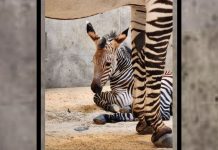
DAVIS, Calif., Jan. 22 (UPI) — For decades, scientists have been trying to explain zebra stripes. Most believe the stripes serve the purpose of camouflage, but scientists at the University of California, Davis say we’ve been studying zebras and their iconic black and white coats with the wrong set of eyes — human eyes.
Zebras generally aren’t worried about avoiding humans. They’re concerned with lions, tigers, cheetahs and other big cats. So biologists from the United States and Canada assumed the perspective of Africa’s biggest hunters.
“We … carried out a series of calculations through which we were able to estimate the distances at which lions and spotted hyenas, as well as zebras, can see zebra stripes under daylight, twilight, or during a moonless night,” lead study author Amanda Melin, an assistant professor of biological anthropology at the University of Calgary, explained in a press release.
Using their best understanding of feline eyesight, researchers estimated the distances at which zebra predators would be able to distinguish a striped pattern.
In woodlands or among shrubs, on a moonless night, when most big cats hunt, zebra stripes would only be distinguishable at 29 feet, and they’d only be visible inside 98 feet at twilight. Researchers determined that at such short distances, predators would be able to locate prey by sound and smell — rendering stripes ineffective as a camouflage tool.
The research also showed that zebras themselves can’t distinguish between striped and solid patterns at long distances, suggesting stripes fail to serve a social purpose.
The new findings are described in a new paper published in the journal PLOS ONE.
“The results from this new study provide no support at all for the idea that the zebra’s stripes provide some type of anti-predator camouflaging effect,” said study co-author Tim Caro, a UC Davis professor of wildlife biology. “Instead, we reject this long-standing hypothesis that was debated by Charles Darwin and Alfred Russell Wallace.”





